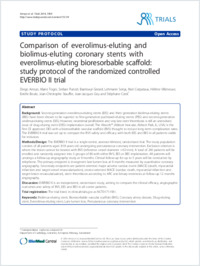Comparison of everolimus-eluting and biolimus-eluting coronary stents with everolimus-eluting bioresorbable scaffold: study protocol of the randomized controlled EVERBIO II trial
- Arroyo, Diego Department of Cardiology, University of Fribourg & Hospital, Fribourg, Switzerland
- Togni, Mario Department of Cardiology, University of Fribourg & Hospital, Fribourg, Switzerland
- Puricel, Serban Department of Cardiology, University of Fribourg & Hospital, Fribourg, Switzerland
- Baeriswyl, Gérard Department of Cardiology, University of Fribourg & Hospital, Fribourg, Switzerland
- Lehmann, Sonja Department of Cardiology, University of Fribourg & Hospital, Fribourg, Switzerland
- Corpataux, Noé Department of Cardiology, University of Fribourg & Hospital, Fribourg, Switzerland
- Villeneuve, Hélène Department of Cardiology, University of Fribourg & Hospital, Fribourg, Switzerland
- Boute, Estelle Department of Cardiology, University of Fribourg & Hospital, Fribourg, Switzerland
- Stauffer, Jean-Christophe Department of Cardiology, University of Fribourg & Hospital, Fribourg, Switzerland
- Goy, Jean-Jacques Department of Cardiology, University of Fribourg & Hospital, Fribourg, Switzerland
- Cook, Stéphane Department of Cardiology, University of Fribourg & Hospital, Fribourg, Switzerland
-
07.01.2014
Published in:
- Trials. - 2014, vol. 15, no. 1, p. 9
Biolimus-eluting stent
Bioresorbable vascular scaffold (BVS)
Coronary artery disease
Drug-eluting stent
Everolimus-eluting stent
Late lumen loss
Percutaneous coronary intervention
English
Background: Second-generation everolimus-eluting stents (EES) and third generation biolimus-eluting stents (BES) have been shown to be superior to first-generation paclitaxel-eluting stents (PES) and second-generation sirolimus-eluting stents (SES). However, neointimal proliferation and very late stent thrombosis is still an unresolved issue of drug-eluting stent (DES) implantation overall. The Absorb™ (Abbott Vascular, Abbott Park, IL, USA) is the first CE approved DES with a bioresorbable vascular scaffold (BVS) thought to reduce long-term complication rates. The EVERBIO II trial was set up to compare the BVS safety and efficacy with both EES and BES in all patients viable for inclusion.Methods/Design: The EVERBIO II trial is a single-center, assessor-blinded, randomized trial. The study population consists of all patients aged ≥18 years old undergoing percutaneous coronary intervention. Exclusion criterion is where the lesion cannot be treated with BVS (reference vessel diameter >4.0 mm). A total of 240 patients will be enrolled and randomly assigned into 3 groups of 80 with either BVS, EES or BES implantation. All patients will undergo a follow-up angiography study at 9 months. Clinical follow-up for up to 5 years will be conducted by telephone. The primary endpoint is in-segment late lumen loss at 9 months measured by quantitative coronary angiography. Secondary endpoints are patient-oriented major adverse cardiac event (MACE) (death, myocardial infarction and target-vessel revascularization), device-oriented MACE (cardiac death, myocardial infarction and target-lesion revascularization), stent thrombosis according to ARC and binary restenosis at follow-up 12 months angiography.Discussion: EVERBIO II is an independent, randomized study, aiming to compare the clinical efficacy, angiographic outcomes and safety of BVS, EES and BES in all comer patients.Trial registration: The trial listed in clinicaltrials.gov as NCT01711931.
- Faculty
- Faculté des sciences et de médecine
- Department
- Médecine 3ème année
- Language
-
- English
- Classification
- Medicine
- License
- License undefined
- Identifiers
-
- RERO DOC 209425
- DOI 10.1186/1745-6215-15-9
- Persistent URL
- https://folia.unifr.ch/unifr/documents/303617
Statistics
Document views: 59
File downloads:
- coo_cee.pdf: 134
